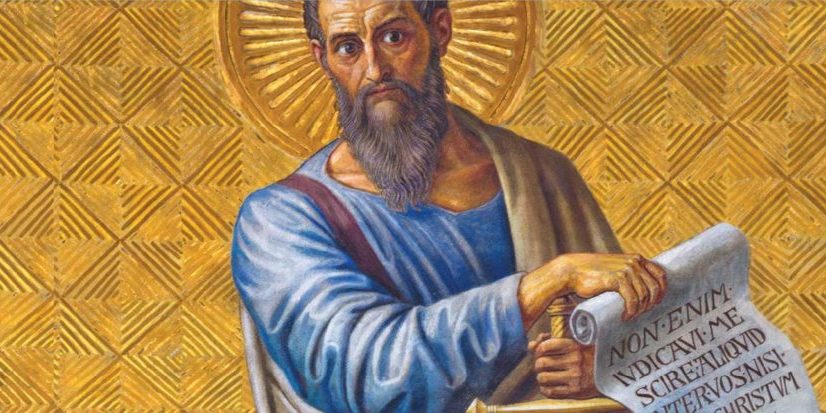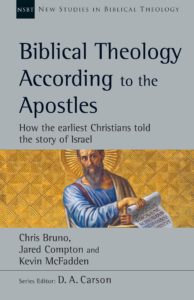
Biblical Theology According to the Apostles
I have benefited greatly from the study of the use of the OT in the NT. I took courses on this subject and have written on it in a few different settings. However, most of the study I’ve done on this topic has been particularly focused on the use of a specific OT text or texts in a specific NT passage. Many books or articles follow similar patterns. There is, however, a difference between tracking the connection between one OT passage and one NT passage and looking at places where the NT tells the wider scope of the story of the OT and particularly the story of Israel. And seeing the wider lens of the whole story of Israel could in fact provide more depth of understanding the biblical theology of the NT writers. In our recent book, Jared Compton, Kevin McFadden, and I are attempting to do just that.
The Wider Scope of the Story
Several years back, my friend and now colleague at Bethlehem College & Seminary, Jared Compton, pointed out to Kevin McFadden and me the places where the authors of the NT tell the story of Israel. Others have written very helpful articles considering this compositional category (summaries of Israel’s story or SIS) and its place in light of similar summaries in both the OT and other early Jewish writings. However, few have analyzed each summary or consider how they function as examples of the biblical theology of the NT authors.
This led to many long conversations and an even longer process of working through the summaries together. After some back and forth, we agreed to focus on seven places in the NT: The genealogy in the Gospel of Matthew (Matt 1:1–17), the parable of the wicked tenants (as told in Matt 21:33–44), Stephen’s speech (Acts 7), Paul’s sermon in Pisidian Antioch (Acts 13:16–41), Paul’s account of Israel’s story in Gal 3–4 and Rom 9–11, and finally the “hall of faith” in Heb 11. Since we have inspired examples of how to read the OT, the NT must influence the way we read the OT. Click To Tweet
This project has a special significance for all three of us co-authors because we actually grew up together through elementary and high school. All of us went on to do advanced study in NT and biblical theology and are now teaching at higher educational institutions (Jared and I now at Bethlehem College & Seminary in Minneapolis, Kevin at Cairn University near Philadelphia). In the final stages of working on the book, we met up in Kenosha, Wisconsin for a few days of marathon sessions of hammering out our final differences. Because we have such a long history together, we felt like we could really go after each other to improve the book. We all have unique strengths and weaknesses, but we hope that the book highlights the former more than the latter!
Standing in Plain Sight
Our goal in the book is to consider the foundations that the use of the OT in the NT is built on. Or, as we say in the book, to consider the submerged part of the iceberg that is the NT’s understanding of the OT. Referring to the studies of particular uses of the OT I mentioned above, we wrote:
If we use the metaphor of an iceberg, many of these studies have been deep-sea explorations attempting to shine a spotlight on things that are submersed in dark and frigid places, such as Paul’s Pharisaic training (midrash) or the philosophical echo chamber in which ancient texts find new resonations (intertextuality). We have all benefited from these studies but our project takes a more direct approach. Our goal is to explore those parts of the iceberg that are standing in plain sight under the light of the sun. Sometimes the most difficult thing to observe carefully is the thing that you see all the time, such as the famous ‘hall of faith’ in Hebrews 11. And yet Hebrews 11 is not only one of most important examples of the use of the OT in the NT, but is also an inspired example of how to put the story of the Bible together (p. 2).
Each chapter focuses on the context, the content, and the contributions of these summaries of Israel’s story. As we trace each story, we observe the plot structure of each story and the particular contributions of each to the biblical theology of the NT. In the last chapter, we pull together our insights from the individual SIS and consider how we might let them shape our own readings of Israel’s stories. The retellings of Israel’s story in the NT should influence the way we read the OT and give us a clear sense of the overall scope of the plot, characters, and methods of the NT authors as they read the NT. In other words, since we have inspired examples of how to read the OT, the NT must influence the way we read the OT.
Ultimately, our readings of the SIS in the NT should shape not only our hermeneutics but also our lives. We conclude the chapter and the book as follows:
The SIS in the NT ought to reorient our priorities when reading the OT and retelling this story. These summaries instruct us about the climax of the story with Christ, the continuation of the story in the church and the conclusion of the story in the new creation. Although the apostles emphasized certain aspects of the story of Israel that fit their context and argumentative situations well, all of the stories of Israel in the NT are faithful retellings of the story of Israel. While we cannot say that the writers of the NT were always operating with the story of Israel explicitly in view, the assumptions that these stories reveal are invariably connected to their other uses of Scripture and should therefore influence our overall understanding of the use of the OT in the NT.
 Not only should these retellings influence our exegesis of the citations of the OT, but also for those who are seeking to live faithfully according to the Scriptures, understanding the story of Israel and our place in this ongoing story is of utmost importance. As Lesslie Newbigin reminds us:
Not only should these retellings influence our exegesis of the citations of the OT, but also for those who are seeking to live faithfully according to the Scriptures, understanding the story of Israel and our place in this ongoing story is of utmost importance. As Lesslie Newbigin reminds us:
Authentic Christian thought and action begin not by attending to the aspirations of people, not by answering the questions they are asking in their terms, not by offering solutions to the problems as the world sees them. It must begin and continue by attending to what God has done in the story of Israel and supremely in the story of Jesus Christ. It must continue by indwelling that story so that it is our story, the way we understand the real story. And then, and this is the vital point, to attend with open hearts and minds to the real needs of people.
Let us go and do likewise.

